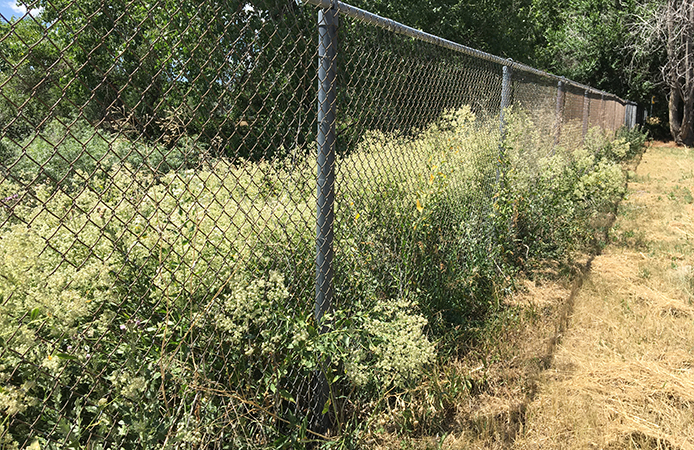Mayweed chamomile
Anthemis cotula L.
Keys to Identification
- Strong odor
- Leaves resemble fennel
This information courtesy of the Colorado Natural Areas Program
Family
Sunflower (Asteraceae)
Other Names
Dog fennel, mayweed, stinking chamomile, stinkweed
USDA Code
ANCO2
Legal Status
Colorado Noxious Weed List B
Identification
Lifecycle
Annual
Growth form
Forb
Flower
Flowers are solitary and borne at the ends of branches. Flowers are 0.75-1.25 in wide with 12 white ray flowers and a yellow disk center. White ray flowers have 3 distinct teeth. Mid-May-frost.
Seeds/Fruit
Small, single-seeded fruit (achene) with about 10 ribs (Stubbendieck et al. 1995).
Leaves
Leaves are alternate, highly divided into narrow segments, To 1/4 in long.
Stems
Mature plants are from 1/2- 2 ft tall, highly branched, and have a foul odor. Lower portion often turns a maroon color as the stem ages.
Roots
Taproot with secondary fibrous root system.
Seedling
Foliage has an unpleasant odor.
Similar Species
Exotics
Scentless chamomile (Matricaria perforata) is locally common on the western slope, and is sometimes confused with mayweed chamomile (Anthemis cotula). In fact, most populations in the Gunnison basin and Blue River area which have been reported as A. cotula are probably M. perforata. A. cotula is distinguished by the presence of soft chaff (dry membranous bracts or scales) on the receptacle, and has odorous foliage. M. perforatalacks recepticular chaff. Corn chamomile (Anthemis arvensis) is almost identical to mayweed chamomile but can be identified by its lack of odor.
Natives
The native Hymenopappus newberryi has few stem leaves, and is perennial.
Impacts
Agricultural
Contact with mayweed chamomile can cause skin rashes, blistering of livestock muzzles, and irritation to mucous membranes of grazing livestock (Whitson et al.1996). It may also impart a strong flavor to the milk of dairy animals (Whitson et al. 1996).
Ecological
Mayweed chamomile invades disturbed and overgrazed areas.
Habitat and Distribution
General requirements
Mayweed chamomile easily adapts to many different environments and growing conditions. It is commonly found in waste areas, fields, and overgrazed pastures.
Distribution
Found throughout the United States.
Biology/Ecology
Life cycle
Mayweed chamomile germinates readily in the spring and fall. It has a dense, fibrous root system, which spreads rapidly during wet periods. Late summer and fall-germinated seedlings may overwinter as a rosette. In the spring, bolting commences with the elongation of the central stem. Overwintering plants flower in mid-May and spring germinated seedlings flower in June. Flowering stops after a killing frost.
Mode of reproduction
Seed.
Seed production
Can produce up to 960,000 seeds per plant.
Seed bank
Seed may remain viable in the soil for 4-6 years.
References
Colorado Natural Areas Program. 2000. Creating an Integrated Weed Management Plan: A Handbook for Owners and Managers of Lands with Natural Values. Colorado Natural Areas Program, Colorado State Parks, Colorado Department of Natural Resources; and Division of Plant Industry, Colorado Department of Agriculture. Denver, Colorado. 349 pages.
Stubbendieck, J., G.Y. Friisoe and M.R. Bolick. 1995. Mayweed. Weeds of Nebraska and the Great Plains. Nebraska Department of Agriculture, Bureau of Plant Industry, Lincoln, Nebraska. pg. 75.
USDA, NRCS. 2005. The PLANTS Database, Version 3.5 (http://plants.usda.gov). Data compiled from various sources by Mark W. Skinner. National Plant Data Center, Baton Rouge, LA 70874-4490 USA
Virginia Tech University. (n.d.) Mayweed Chamomile: Anthemis cotula. Retrieved 11/04/2005 http://www.ppws.vt.edu/scott/weed_id/antco.htm
Whitson, T.D.(ed.), L.C. Burrill, S.A. Dewey, D.W. Cudney, B.E. Nelson, R.D. Lee, R. Parker. 1996. Mayweed chamomile. Weeds of the West. Western Society of Weed Science, in cooperation with the Western United States Land Grant Universities Cooperative Extension Services, Newark CA. pg. 54.

